Self-Sufficient Carbon Emission Reduction in Resource-Based Cities: Evidence of Green Technology Innovation
Abstract
1. Introduction
2. Research Area, Methods, and Data
2.1. Research Area
2.2. Methods
2.2.1. Markov Chain
2.2.2. Panel Data Regression Model
2.2.3. Multiperiod Double Difference Model
2.3. Data
Variable Selection
3. Temporal and Spatial Evolution of CEI in RBCs in China
3.1. Characteristics of the Temporal Evolution of the CEI
3.2. Characteristics of the Spatial Evolution of the CEI
4. Analysis of the Effect of GTI on CEI of RBCs
4.1. Regression Analysis of GTI on CEI of RBCs
4.2. Heterogeneity Analysis
4.2.1. Analysis of Heterogeneity at Different Stages of Development
4.2.2. Analysis of the Heterogeneity of Different Resource Types
4.3. The Impact of NHTZs on the Carbon Emission Reduction Effect of GTI
5. Conclusions and Policy Implications
Author Contributions
Funding
Institutional Review Board Statement
Informed Consent Statement
Data Availability Statement
Conflicts of Interest
References
- Ren, Y.F.; Yuan, W.R.; Zhang, B.T.; Wang, S.J. Does improvement of environmental efficiency matter in reducing carbon emission intensity? Fresh evidence from 283 prefecture-level cities in China. J. Clean. Prod. 2022, 373, 133878. [Google Scholar] [CrossRef]
- Liu, X.; Li, Y.C.; Chen, X.H.; Liu, J. Evaluation of low carbon city pilot policy effect on carbon abatement in China: An empirical evidence based on time-varying DID model. Cities 2022, 123, 103582. [Google Scholar] [CrossRef]
- Song, W.X.; Yin, S.G.; Zhang, Y.H.; Qi, L.S.Y.; Yi, X. Spatial-temporal evolution characteristics and drivers of carbon emission intensity of resource-based cities in China. Front. Environ. Sci. 2022, 10, 972563. [Google Scholar] [CrossRef]
- Zhang, W.; Li, G.X.; Guo, F.Y. Does carbon emissions trading promote green technology innovation in China? Appl. Energy 2022, 315, 119012. [Google Scholar] [CrossRef]
- Zhou, J.; Zhang, Z.Y.; Xu, X.B.; Chang, D.H. Does the transformation of resource-dependent cities promote the realization of the carbon-peaking goal? An analysis based on typical resource-dependent city clusters in China. J. Clean. Prod. 2022, 365, 132731. [Google Scholar] [CrossRef]
- Fan, M.T.; Li, M.X.; Liu, J.H.; Shao, S. Is high natural resource dependence doomed to low carbon emission efficiency? Evidence from 283 cities in China. Energy Econ. 2022, 115, 106328. [Google Scholar] [CrossRef]
- Zheng, H.Y.; Ge, L.M. Carbon emissions reduction effects of sustainable development policy in resource-based cities from the perspective of resource dependence: Theory and Chinese experience. Resour. Policy 2022, 78, 102799. [Google Scholar] [CrossRef]
- Zhang, R.J.; Tai, H.W.; Cao, Z.X.; Wei, C.C.; Cheng, K.T. Green innovation ecosystem evolution: Diffusion of positive green innovation game strategies on complex networks. J. Innov. Knowl. 2024, 9, 100500. [Google Scholar] [CrossRef]
- Zhao, Z.Y.; Zhou, S.N.; Wang, S.Y.; Ye, C.; Wu, T. The Impact of Carbon Emissions Trading Pilot Policy on Industrial Structure Upgrading. Sustainability 2022, 14, 10818. [Google Scholar] [CrossRef]
- Wang, F.S.; Cai, W.X.; Elahi, E. Do Green Finance and Environmental Regulation Play a Crucial Role in the Reduction of CO2 Emissions? An Empirical Analysis of 126 Chinese Cities. Sustainability 2021, 13, 13014. [Google Scholar] [CrossRef]
- Gao, P.F.; Wang, Y.D.; Zou, Y.; Su, X.F.; Che, X.H.; Yang, X.D. Green technology innovation and carbon emissions nexus in China: Does industrial structure upgrading matter? Front. Psychol. 2022, 13, 951172. [Google Scholar] [CrossRef]
- Shan, S.; Genç, S.Y.; Kamran, H.W.; Dinca, G. Role of green technology innovation and renewable energy in carbon neutrality: A sustainable investigation from Turkey. J. Environ. Manag. 2021, 294, 113004. [Google Scholar] [CrossRef] [PubMed]
- Cai, A.X.; Zheng, S.Y.; Cai, L.H.; Yang, H.M.; Comite, U. How Does Green Technology Innovation Affect Carbon Emissions? A Spatial Econometric Analysis of China’s Provincial Panel Data. Front. Environ. Sci. 2021, 9, 813811. [Google Scholar] [CrossRef]
- Xin, D.L.; Ahmad, M.; Khattak, S.I. Impact of innovation in climate change mitigation technologies related to chemical industry on carbon dioxide emissions in the United States. J. Clean. Prod. 2022, 379, 134746. [Google Scholar] [CrossRef]
- Paramati, S.R.; Di, M.; Huang, R.X. The role of financial deepening and green technology on carbon emissions: Evidence from major OECD economies. Financ. Res. Lett. 2021, 41, 101794. [Google Scholar] [CrossRef]
- Chen, Y.Y.; Yao, Z.Y.; Zhong, K. Do environmental regulations of carbon emissions and air pollution foster green technology innovation: Evidence from China’s prefecture-level cities. J. Clean. Prod. 2022, 350, 131537. [Google Scholar] [CrossRef]
- Zhang, M.L.; Liu, Y. Influence of digital finance and green technology innovation on China’s carbon emission efficiency: Empirical analysis based on spatial metrology. Sci. Total Environ. 2022, 838, 156463. [Google Scholar] [CrossRef]
- Wang, L.; Chen, Y.Y.; Ramsey, T.S.; Hewings, G.J.D. Will researching digital technology really empower green development? Technol. Soc. 2021, 66, 101638. [Google Scholar] [CrossRef]
- Wang, Z.C.; Zhou, X.L. Can Innovation-Driven Policy Reduce China’s Carbon Emission Intensity?—A Quasi-Natural Experiment Based on the National Innovative City Pilot Policy. Sustainability 2023, 15, 4383. [Google Scholar] [CrossRef]
- Khattak, S.I.; Ahmad, M.; ul Haq, Z.; Gao, S.F.; Hang, J. On the goals of sustainable production and the conditions of environmental sustainability: Does cyclical innovation in green and sustainable technologies determine carbon dioxide emissions in G-7 economies. Sustain. Prod. Consum. 2022, 29, 406–420. [Google Scholar] [CrossRef]
- Ahmed, N.; Areche, F.O.; Nieto, D.D.C.; Borda, R.F.C.; Gonzales, B.C.; Senkus, P.; Siemiński, P.; Skrzypek, A. Nexus between Cyclical Innovation in Green Technologies and CO2 Emissions in Nordic Countries: Consent toward Environmental Sustainability. Sustainability 2022, 14, 11768. [Google Scholar] [CrossRef]
- Wang, N.; Yu, H.F.; Shu, Y.L.; Chen, Z.; Li, T.C. Can green patents reduce carbon emission intensity?—An empirical analysis based on China’s experience. Front. Environ. Sci. 2022, 10, 1084977. [Google Scholar] [CrossRef]
- Du, K.R.; Li, P.Z.; Yan, Z.M. Do green technology innovations contribute to carbon dioxide emission reduction? Empirical evidence from patent data. Technol. Forecast. Soc. Change 2019, 146, 297–303. [Google Scholar] [CrossRef]
- Chen, H.Y.; Yi, J.Z.; Chen, A.B.; Peng, D.X.; Yang, J.Q. Green technology innovation and CO2 emission in China: Evidence from a spatial-temporal analysis and a nonlinear spatial durbin model. Energy Policy 2023, 172, 113338. [Google Scholar] [CrossRef]
- Li, Y.H.; Chai, X.Y.; Su, R.Q.; Chen, K.D. Impact of accelerated depreciation policies for fixed assets on firms’ green innovation performance. Financ. Res. Lett. 2025, 74, 106816. [Google Scholar] [CrossRef]
- Fan, X.J.; Wu, S.M.; Lei, Y.L.; Li, S.T.; Li, L. Have China’s resource-based regions improved in the division of GVCs?—Taking Shanxi Province as an example. Resour. Policy 2020, 68, 101725. [Google Scholar] [CrossRef]
- Liu, P.; Zhou, H.J.; Chun, X.; Wan, Z.Q.; Liu, T.; Sun, B.; Wang, J.W.; Zhang, W.H. Characteristics of fine carbonaceous aerosols in Wuhai, a resource-based city in Northern China: Insights from energy efficiency and population density. Environ. Pollut. 2022, 292, 118368. [Google Scholar] [CrossRef]
- Küpper, M.; Quass, U.; John, A.C.; Kaminski, H.; Leinert, S.; Breuer, L.; Gladtke, D.; Weber, S.; Kuhlbusch, T.A.J. Contributions of carbonaceous particles from fossil emissions and biomass burning to PM10 in the Ruhr area, Germany. Atmos. Environ. 2018, 189, 174–186. [Google Scholar] [CrossRef]
- Qiu, F.D.; Yuan, H.; Bai, L.Y.; Li, F. Spatial-temporal heterogeneity of industrial structure transformation and carbon emission effect in Xuzhou Metropolitan Area. Chin. Geogr. Sci. 2017, 27, 904–917. [Google Scholar] [CrossRef][Green Version]
- Kuai, P.; Li, W.; Cheng, R.H.; Cheng, G. An application of system dynamics for evaluating planning alternatives to guide a green industrial transformation in a resource-based city. J. Clean. Prod. 2015, 104, 403–412. [Google Scholar] [CrossRef]
- Jing, Z.R.; Wang, J.M. Sustainable development evaluation of the society–economy–environment in a resource-based city of China: A complex network approach. J. Clean. Prod. 2020, 263, 121510. [Google Scholar] [CrossRef]
- Li, Z.; Cai, Y.P.; Lin, G. Pathways for sustainable municipal energy systems transition: A case study of Tangshan, a resource-based city in China. J. Clean. Prod. 2022, 330, 129835. [Google Scholar] [CrossRef]
- Zhao, M.; Zhang, X.Q.; Wang, C.X.; Zhao, Y.; Wu, G. Research on Residents’ Willingness to Pay for Promoting the Green Development of Resource-Based Cities: A Case Study in Chifeng. Sustainability 2021, 13, 2833. [Google Scholar] [CrossRef]
- Cheng, Z.H.; Li, X.; Wang, M.X. Resource curse and green economic growth. Resour. Policy 2021, 74, 102325. [Google Scholar] [CrossRef]
- Qian, Q.L.; Luo, S.C. The dilemma of land green use efficiency in resource-based cities: A perspective based on digital transformation. Front. Environ. Sci. 2024, 12, 1339928. [Google Scholar] [CrossRef]
- Qian, L.; Xu, X.L.; Sun, Y.; Zhou, Y.J. Carbon emission reduction effects of eco-industrial park policy in China. Energy 2022, 261, 125315. [Google Scholar] [CrossRef]
- Song, M.L.; Zhao, X.; Shang, Y.P. The impact of low-carbon city construction on ecological efficiency: Empirical evidence from quasi-natural experiments. Resour. Conserv. Recycl. 2020, 157, 104777. [Google Scholar] [CrossRef]
- Li, B.; Tu, Y.X.; Liu, J. Impact of Industrial Transformation and Upgrading Demonstration Zones on carbon emissions intensity in resource-based cities. J. Environ. Plan. Manag. 2025, 68, 1037–1056. [Google Scholar] [CrossRef]
- Zhang, H.T.; Sun, X.M.; Bi, C.F.; Ahmad, M.; Wang, J. Can sustainable development policy reduce carbon emissions? Empirical evidence from resource-based cities in China. Sci. Total Environ. 2022, 838, 156341. [Google Scholar] [CrossRef]
- Chen, W.; Chen, W.J.; Ning, S.Y.; Liu, E.N.; Zhou, X.; Wang, Y.N.; Zhao, M.J. Exploring the industrial land use efficiency of China’s resource-based cities. Cities 2019, 93, 215–223. [Google Scholar] [CrossRef]
- Cai, X.Y.; Xiang, H.; Zheng, H.T. Impact of energy consumption patterns on peak emissions in China’s carbon neutralisation process. Energy Strategy Rev. 2024, 55, 101501. [Google Scholar] [CrossRef]
- Pan, M.J.; Zhao, X.; Lv, K.J.; Rosak-Szyrocka, J.; Mentel, G.; Truskolaski, T. Internet development and carbon emission-reduction in the era of digitalization: Where will resource-based cities go? Resour. Policy 2023, 81, 103345. [Google Scholar] [CrossRef]
- Zhao, Y.B.; Chen, R.Y.; Zang, P.; Huang, L.Q.; Ma, S.F.; Wang, S.J. Spatiotemporal patterns of global carbon intensities and their driving forces. Sci. Total Environ. 2022, 818, 151690. [Google Scholar] [CrossRef] [PubMed]
- Cheng, Y.; Zhang, Y.; Wang, J.J.; Jiang, J.X. The impact of the urban digital economy on China’s carbon intensity: Spatial spillover and mediating effect. Resources. Conserv. Recycl. 2023, 189, 106762. [Google Scholar] [CrossRef]
- Weng, Z.X.; Zhong, M.; Yang, X.; Cheng, C.Y. Effect of China’s carbon market on the promotion of green technological innovation. J. Clean. Prod. 2022, 373, 133820. [Google Scholar] [CrossRef]
- Huang, S.F.; Ge, J.P. Do environmental regulations truly reduce risks? Evidence from the heterogeneity of resource-based cities. Risk Anal. 2025; Early View. [Google Scholar] [CrossRef]
- Li, Y.C.; Zhao, L.; Suo, J.J. Comprehensive Assessment on Sustainable Development of Highway Transportation Capacity Based on Entropy Weight and TOPSIS. Sustainability 2014, 6, 4685–4693. [Google Scholar] [CrossRef]
- Yang, H.S.; Tang, M.; Chao, X.R.; Li, P. How environmental regulation influences the green economy efficiency of resource-based cities: An empirical study from China. Environ. Dev. Sustain. 2024, 26, 27249–27276. [Google Scholar] [CrossRef]
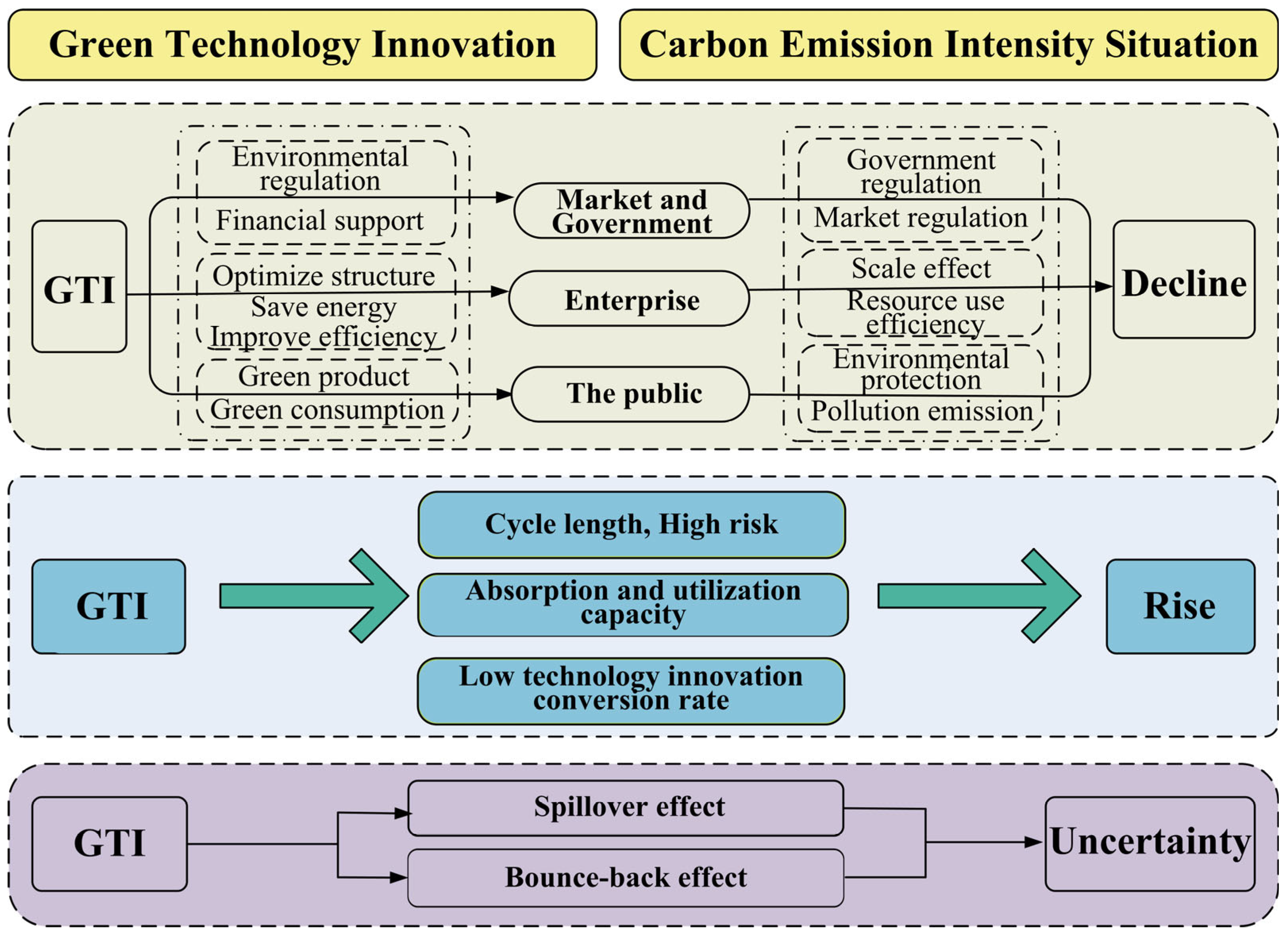

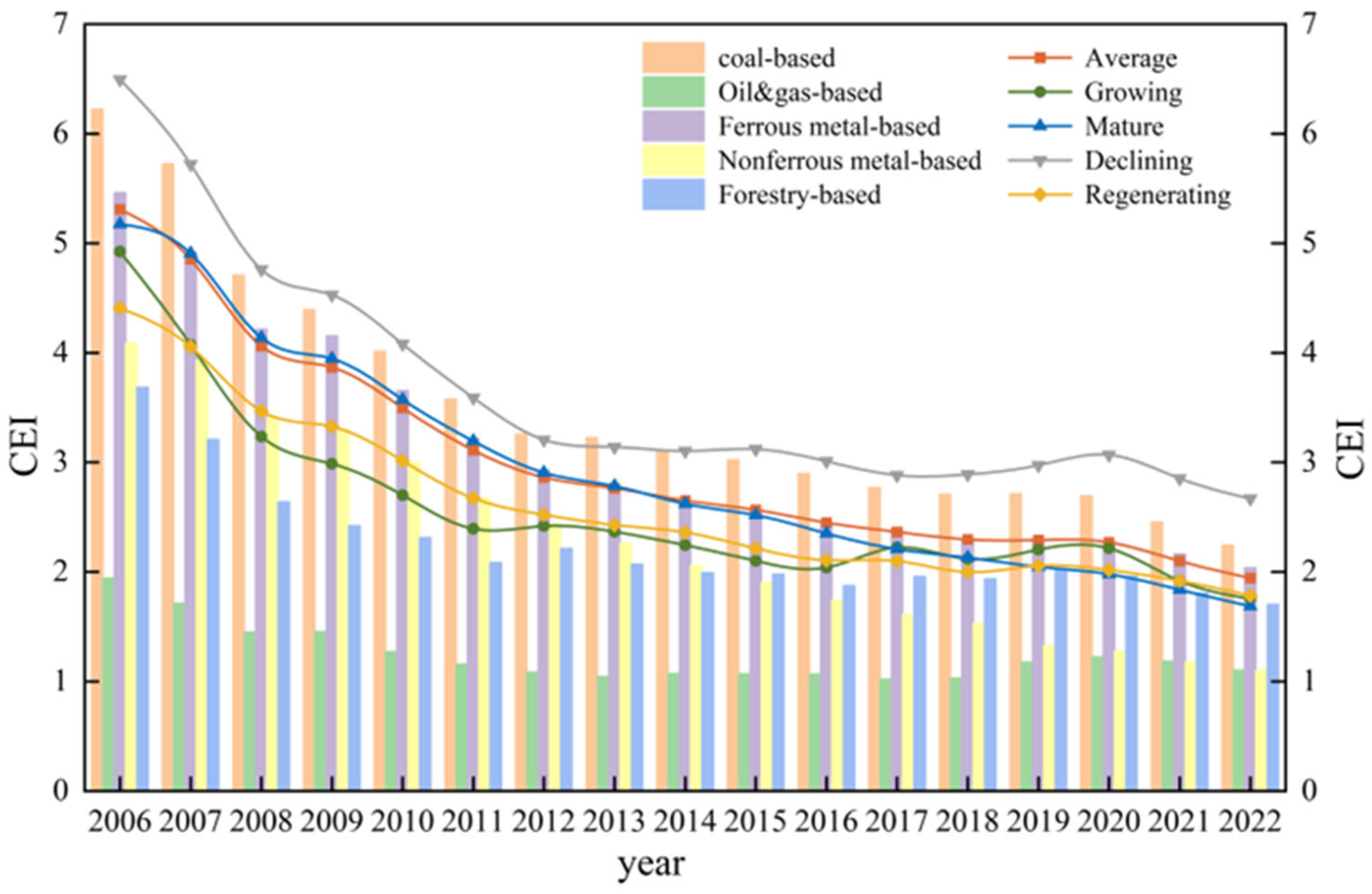
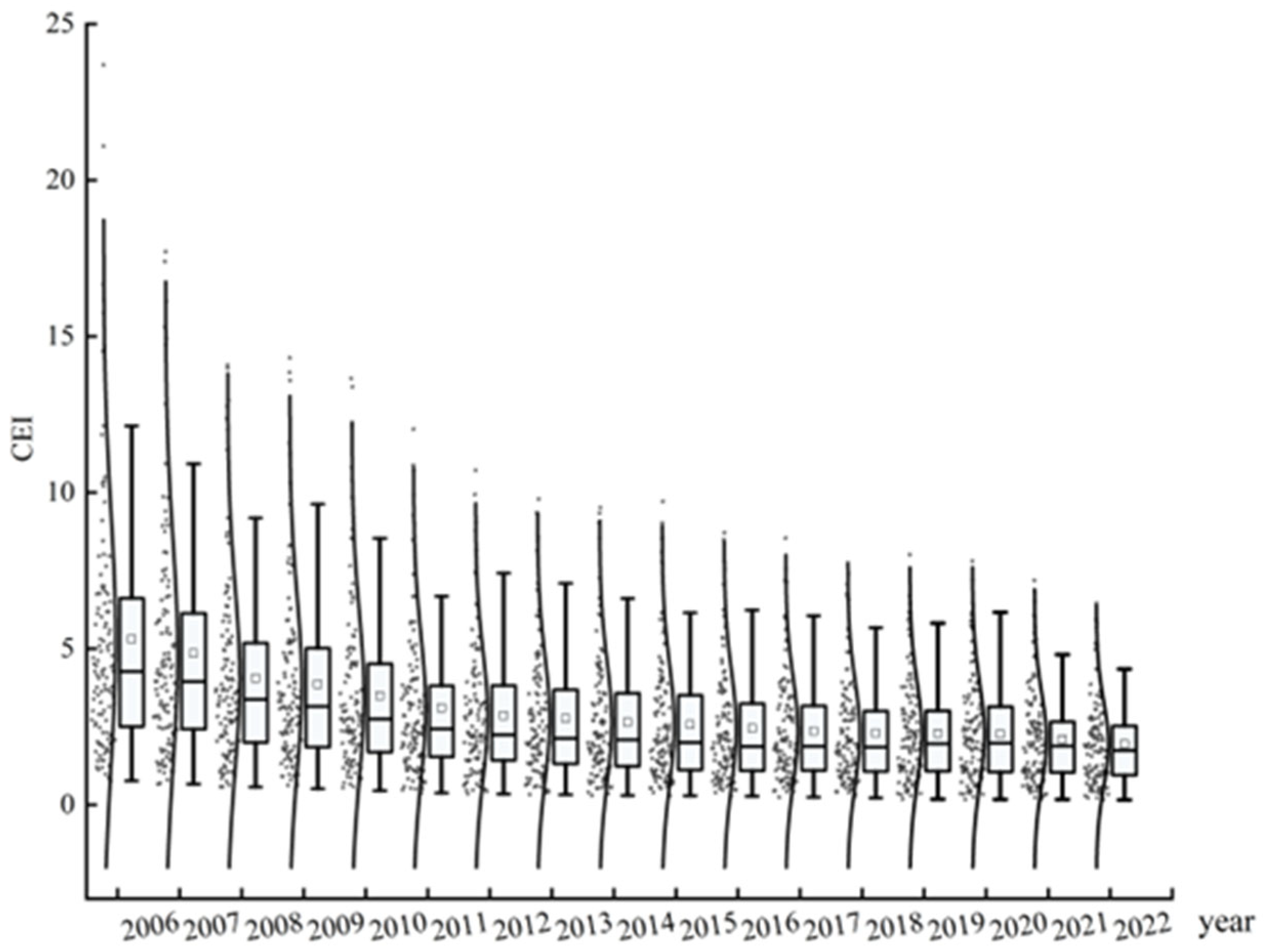
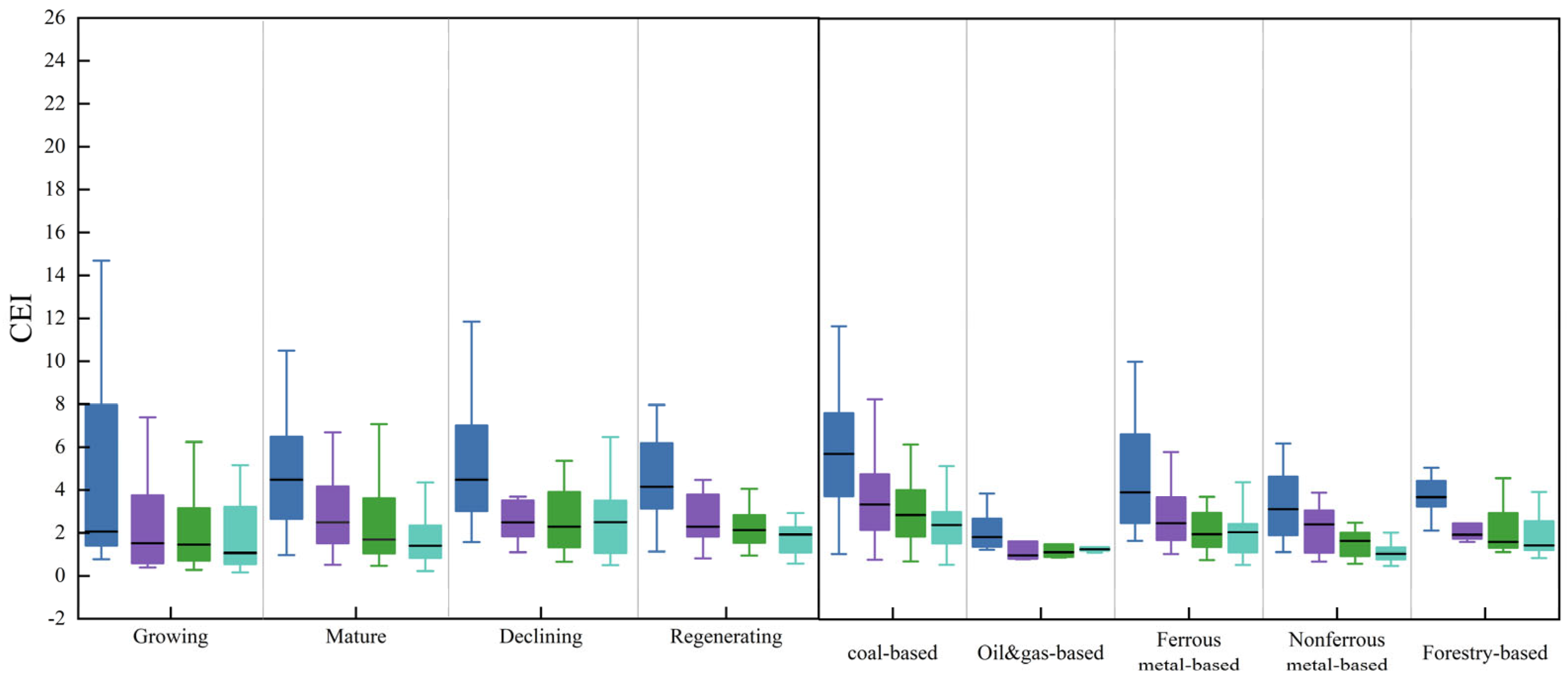

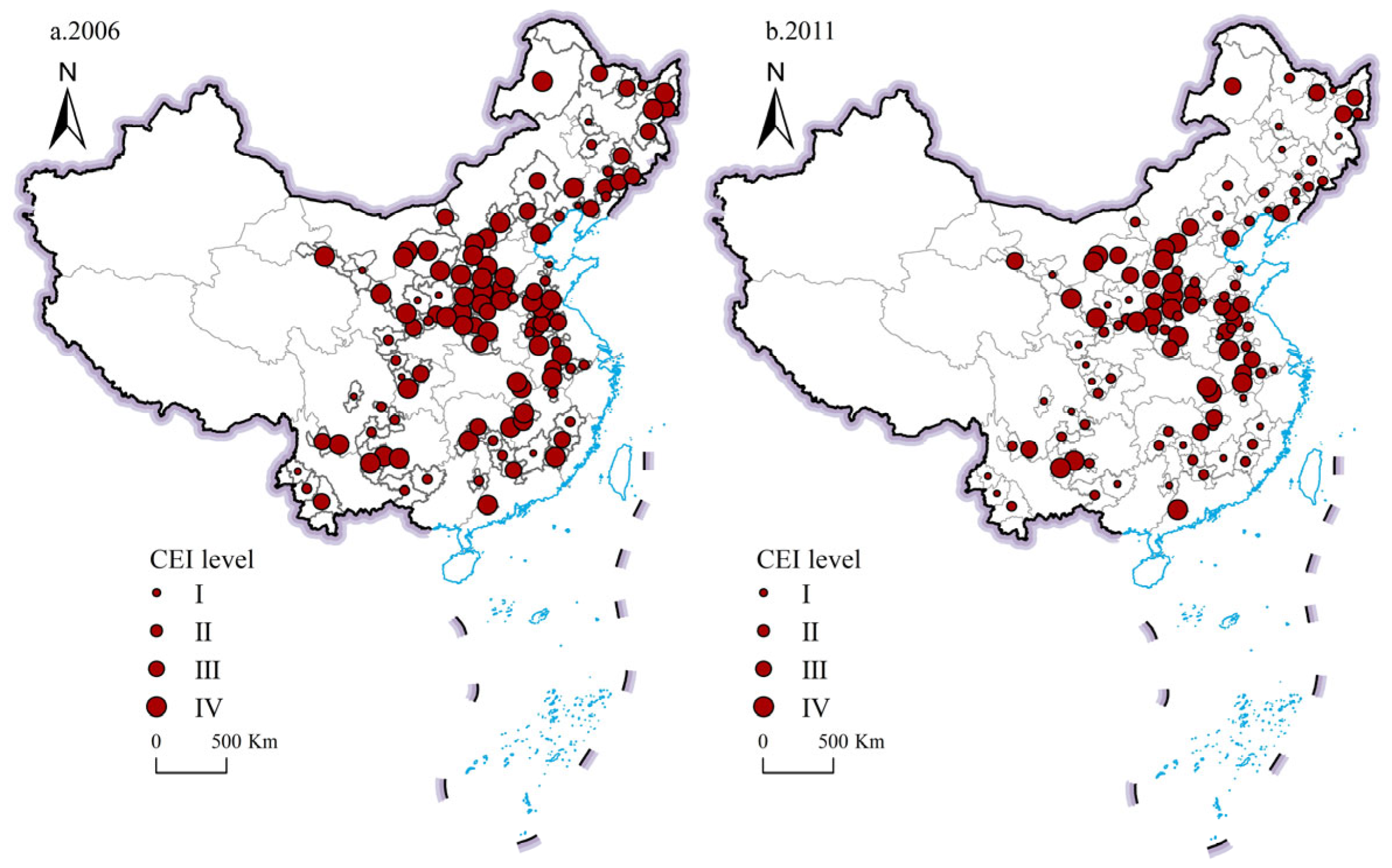
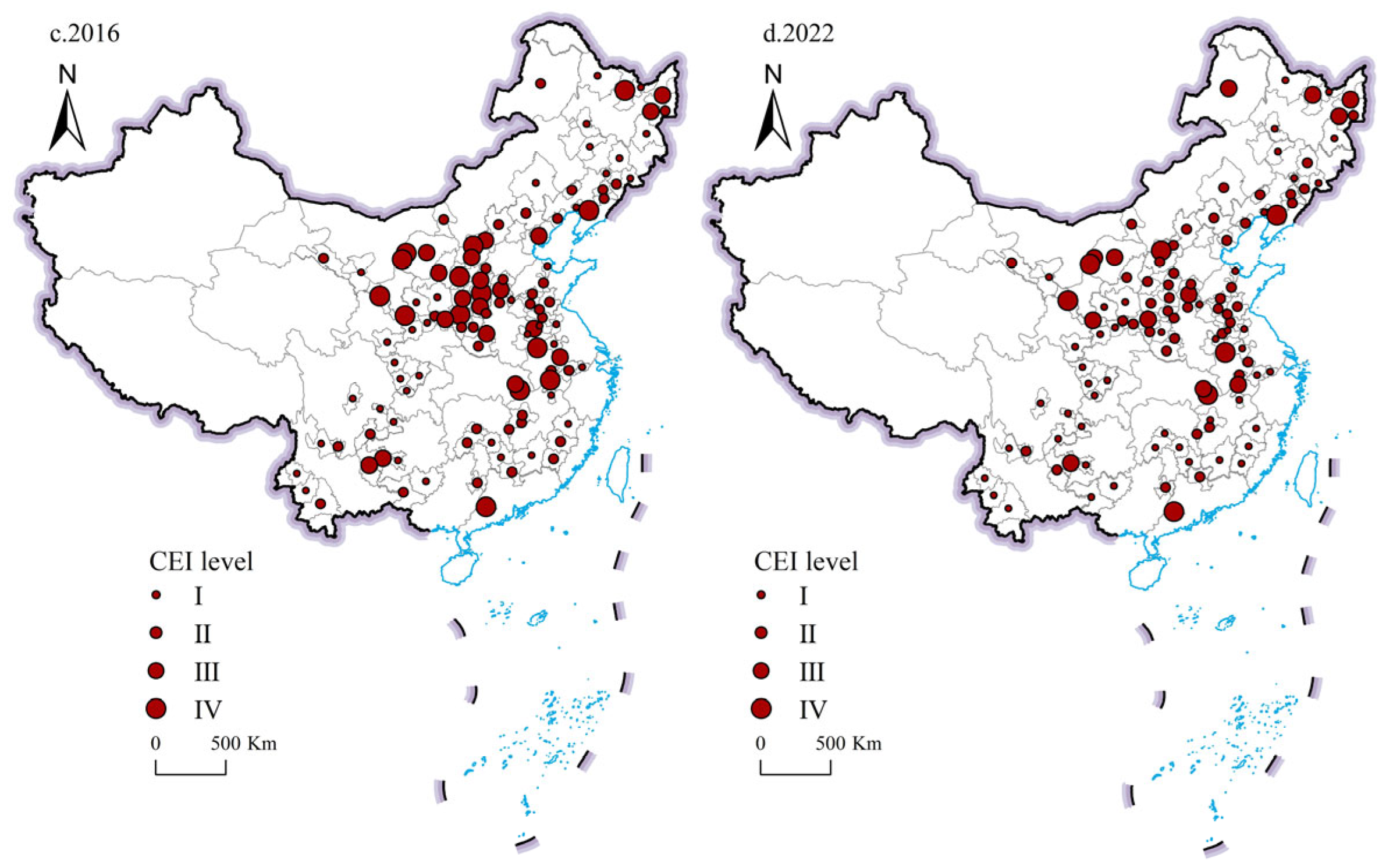
| States | I | II | III | IV | n |
|---|---|---|---|---|---|
| I | 0.9766 | 0.0234 | 0.0000 | 0.0000 | 428 |
| II | 0.1141 | 0.8255 | 0.0582 | 0.0022 | 447 |
| III | 0.0000 | 0.1733 | 0.7933 | 0.0333 | 450 |
| IV | 0.0000 | 0.0000 | 0.1478 | 0.8522 | 467 |
| (1) | (2) | (3) | OLS | |
|---|---|---|---|---|
| lnGTI | −0.197 *** | −0.185 *** | −0.033 *** | −0.084 *** |
| (−30.61) | (−28.38) | (−3.38) | (−6.44) | |
| lnIS | −0.431 *** | −0.404 *** | −0.599 *** | 0.172 ** |
| (−10.92) | (−10.33) | (−13.93) | (2.52) | |
| lnPD | 0.179 *** | −0.786 *** | −0.772 *** | 0.292 *** |
| (2.70) | (−5.93) | (−6.44) | (6.49) | |
| lnRE | 0.042 *** | 0.037 *** | 0.029 *** | 0.139 *** |
| (4.63) | (4.06) | (3.44) | (10.99) | |
| lnTRAN | −0.346 *** | −0.394 *** | −0.168 *** | −0.318 *** |
| (−9.16) | (−10.51) | (−4.74) | (−4.99) | |
| lnER | −0.085 *** | −0.087 *** | −0.025 ** | 0.079 ** |
| (−6.67) | (−7.02) | (−2.13) | (2.34) | |
| Cons | 2.384 *** | 7.469 *** | 7.912 *** | −1.709 *** |
| (6.40) | (10.71) | (12.32) | (−4.64) | |
| R2 | 0.638 | 0.638 | 0.711 | 0.140 |
| Growing | Mature | Declining | Regenerating | |||||
|---|---|---|---|---|---|---|---|---|
| fe | re | fe | re | fe | re | fe | re | |
| lnGTI | 0.067 *** | −0.078 *** | −0.208 *** | −0.224 *** | −0.180 *** | −0.181 *** | −0.230 *** | −0.239 *** |
| (−2.65) | (−3.43) | (−25.18) | (−27.59) | (−14.25) | (−13.96) | (−11.82) | (−12.20) | |
| Cons | 3.239 | 1.107 | 8.035 *** | 1.473 ** | 6.680 *** | 3.341 *** | 10.743 *** | 4.831 *** |
| (1.26) | (0.89) | (7.51) | (2.49) | (5.80) | (4.90) | (6.99) | (5.65) | |
| Control variable | YES | YES | YES | YES | YES | YES | YES | YES |
| R2 | 0.434 | 0.432 | 0.746 | 0.739 | 0.560 | 0.550 | 0.683 | 0.660 |
| Coal-Based | Oil- and Gas-Based | Ferrous Metal-Based | Nonferrous Metal-Based | Forestry-Based | ||||||
|---|---|---|---|---|---|---|---|---|---|---|
| fe | re | fe | re | fe | fe | re | fe | re | fe | |
| lnGTI | −0.186 *** | −0.193 *** | −0.063 | −0.041 | −0.177 *** | −0.185 *** | −0.192 *** | −0.202 *** | −0.129 *** | −0.122 *** |
| (−19.63) | (−20.70) | (−1.43) | (−1.41) | (−12.42) | (−12.77) | (−14.63) | (−16.10) | (−5.42) | (−5.47) | |
| Cons | 5.222 *** | 1.566 *** | 20.466 *** | 3.019 *** | 8.814 *** | 2.568 *** | 5.413 ** | 1.392 | 4.738 ** | 2.850 *** |
| (5.63) | (3.04) | (4.40) | (3.77) | (6.49) | (2.92) | (2.35) | (0.82) | (2.28) | (5.27) | |
| Control variable | YES | YES | YES | YES | YES | YES | YES | YES | YES | YES |
| R2 | 0.625 | 0.618 | 0.593 | 0.007 | 0.674 | 0.663 | 0.895 | 0.896 | 0.542 | 0.537 |
| Model 1 | Model 2 | |
|---|---|---|
| NHTZs | −0.114 *** | −0.094 *** |
| (−5.45) | (−4.87) | |
| Cons | 1.426 *** | 7.832 *** |
| (68.73) | (12.28) | |
| Control variable | NO | YES |
| R2 | 0.482 | 0.851 |
Disclaimer/Publisher’s Note: The statements, opinions and data contained in all publications are solely those of the individual author(s) and contributor(s) and not of MDPI and/or the editor(s). MDPI and/or the editor(s) disclaim responsibility for any injury to people or property resulting from any ideas, methods, instructions or products referred to in the content. |
© 2025 by the authors. Licensee MDPI, Basel, Switzerland. This article is an open access article distributed under the terms and conditions of the Creative Commons Attribution (CC BY) license (https://creativecommons.org/licenses/by/4.0/).
Share and Cite
Wang, Y.; Zhao, H.; Wang, D.; Cheng, Y. Self-Sufficient Carbon Emission Reduction in Resource-Based Cities: Evidence of Green Technology Innovation. Sustainability 2025, 17, 5075. https://doi.org/10.3390/su17115075
Wang Y, Zhao H, Wang D, Cheng Y. Self-Sufficient Carbon Emission Reduction in Resource-Based Cities: Evidence of Green Technology Innovation. Sustainability. 2025; 17(11):5075. https://doi.org/10.3390/su17115075
Chicago/Turabian StyleWang, Yaping, Hongxiao Zhao, Dan Wang, and Yu Cheng. 2025. "Self-Sufficient Carbon Emission Reduction in Resource-Based Cities: Evidence of Green Technology Innovation" Sustainability 17, no. 11: 5075. https://doi.org/10.3390/su17115075
APA StyleWang, Y., Zhao, H., Wang, D., & Cheng, Y. (2025). Self-Sufficient Carbon Emission Reduction in Resource-Based Cities: Evidence of Green Technology Innovation. Sustainability, 17(11), 5075. https://doi.org/10.3390/su17115075






